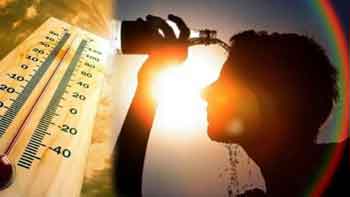As the scorching summer sun continues to blaze, the Delhi-NCR region finds itself grappling with an unrelenting heatwave. The maximum temperature is set to rise again from today, with the mercury climbing to 42 degrees Celsius. The India Meteorological Department (IMD) has predicted that in the coming three days, temperatures could soar beyond 45 degrees Celsius. This relentless heat is now a concern not only during the day but also at night, making the situation increasingly unbearable for residents.
Rajasthan: Battling the Severest of Heat Waves
Rajasthan is currently enduring one of the most severe heatwaves in recent history. According to the IMD, a red alert has been issued for the state. Barmer, in particular, recorded the highest temperature in the country yesterday, with the mercury crossing an alarming 48 degrees Celsius. This extreme heatwave has put immense strain on daily life, with severe implications for health and safety.
Gujarat: Mixed Alerts Amidst Rising Temperatures
In Gujarat, the situation is equally dire, with a red alert issued for severe heat waves in some parts of the state. The rest of the state remains under an orange alert, indicating the need for caution. The persistent high temperatures are affecting agriculture, water supplies, and the overall well-being of the population.
Bihar: A Ray of Hope with Potential Rainfall
Amidst the widespread heat, Bihar offers a glimmer of relief. The IMD has forecasted rain for today, which could bring much-needed respite from the heat. The state capital, Patna, and surrounding areas are expected to experience cloud movements, sporadic drizzles, and strong winds. Northern regions of the state are likely to receive light to moderate rainfall accompanied by thunderstorms, providing a welcome break from the oppressive heat.
Uttar Pradesh: Heat Persists Day and Night
The heatwave in Uttar Pradesh shows no signs of abating. The Meteorological Department predicts severe heat waves from May 24 to 27. Despite a brief decline, temperatures have remained high, with the city recording a maximum of 47.7 degrees Celsius on May 19, the hottest day of the season so far. This intense heat is expected to continue, affecting both daytime and nighttime conditions.
Southern States: Heavy Rain and Thunderstorms Expected
The southern states of India are bracing for a different kind of extreme weather. The IMD has issued warnings for thunderstorms, lightning, and heavy rainfall. Kerala is on high alert for very heavy rainfall accompanied by strong surface winds and thunderstorms. Tamil Nadu and Puducherry are also expecting heavy rain with thunderstorm activities. The regions of Lakshadweep and the Andaman and Nicobar Islands are forecasted to receive significant rainfall, potentially alleviating some heat stress in these areas.
Delhi-NCR: Increasing Heat and Health Risks
The national capital is experiencing a steady increase in temperatures, adding to the discomfort of its residents. With the minimum temperature recorded at 31 degrees Celsius and the maximum at 41 degrees Celsius yesterday, today’s forecast predicts an escalation to 42 degrees Celsius. The IMD warns that temperatures could exceed 45 degrees Celsius in the next three days, posing serious health risks, particularly for vulnerable populations such as the elderly and children. Prolonged exposure to such extreme heat can lead to heat strokes, dehydration, and other heat-related illnesses.
Impact on Daily Life and Health
The ongoing heatwave has significant implications for daily life. High temperatures can severely impact health, leading to increased instances of heat exhaustion and heat stroke. It’s crucial for residents to stay hydrated, avoid direct sunlight during peak hours, and take preventive measures to protect themselves from heat-related ailments. Authorities are urging people to limit outdoor activities and stay in cool, shaded environments as much as possible.
Economic and Environmental Concerns
The economic impact of the heatwave is considerable. Agriculture, a major livelihood for many, suffers immensely due to the high temperatures, affecting crop yields and water resources. The demand for electricity surges as people rely more on air conditioning and fans, straining the power grid and leading to frequent outages. Environmental concerns also rise, as prolonged heatwaves can exacerbate drought conditions, affect wildlife, and disrupt the ecological balance.
Preparedness and Response Measures
Governments at both state and national levels are implementing various measures to mitigate the effects of the heatwave. Public health advisories are being issued, urging citizens to take necessary precautions. Water distribution points are being set up in several areas, and emergency medical services are on high alert to handle cases of heat-related illnesses. Efforts are also being made to ensure the availability of electricity and water to meet the increased demand during this period.
Long-term Strategies and Solutions
Addressing the recurring issue of heatwaves requires long-term strategies and solutions. Urban planning must incorporate green spaces and water bodies to mitigate the urban heat island effect. Afforestation and conservation of water resources are critical in combating the adverse impacts of extreme heat. Public awareness campaigns play a crucial role in educating people about the dangers of heatwaves and the steps they can take to protect themselves.
Global Context and Climate Change
The current heatwave is a stark reminder of the broader issue of climate change. As global temperatures rise, the frequency and intensity of heatwaves are expected to increase. It’s imperative for countries worldwide to collaborate on climate action, reducing greenhouse gas emissions, and investing in sustainable practices to curb the effects of global warming.













